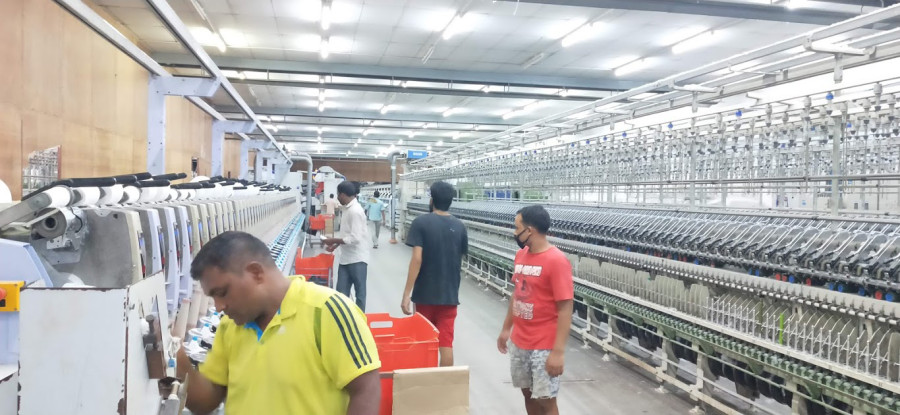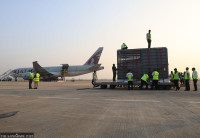Lumbini Province
Industries begin operations in Province 5 with local labour force
Local workforce is filling the vacuum created by foreign migrant workers who left for their home countries when the pandemic hit.
Madhav Dhungana
Many foreign migrant workers employed in cement and steel industries in Rupandehi left for their home country when the pandemic hit and the nationwide lockdown was put in place back on March 24. Most of these migrant workers were from India. The vacuum created by their departure is now being filled by workers from within the country, according to the Province Planning Commission in Province 5.
The data available at the commission showed that more than 200,000 migrant workers in Nepal have returned to India and overseas in the last five months.
“There was a dearth of workers in factories since most migrants from India went back home. But Nepali workers have gradually started working in their stead,” said Ishwor Gautam, the vice-chairperson of the commission.
Although the commission does not have the updated data on all Nepali returnees who are in need of employment, it will soon have the final figures, says Gautam.
“We plan to create jobs and open employment opportunities for the returnees. We are coordinating with the local units to update the data,” Gautam said.
Before the pandemic, most cement and steel factories, among other industries, in Rupandehi had 80 percent workforce from India since the locals used to migrate abroad in search of jobs.
But the scenario has been changed since the pandemic.
“A large chunk of the workforce in various brick kilns and factories in Rupandehi used to be from Uttar Pradesh, Bihar and other states of India. Now locals are working in those factories,” said Gautam.
According to Bidur Dhungana, general secretary at the Western Cement Manufacturers Association, there were around 5,000 to 6,000 foreign migrant workers in various cement and steel industries in Rupandehi and Kapilvastu districts before the lockdown.
“Out of around 40,000 workers in 200 brick kilns, at least 35,000 were from India. But since most of them have returned to their native country, local Nepalis are filling up the vacant positions,” said Thanseshwor Ghimire, chairman of the Federation of Nepal Brick Industries in Province 5.
In the past, locals preferred going abroad for employment, creating a dearth of manpower in the local industries.
“But now, Nepali workers from Rupandehi and other parts of the country have started arriving here for work,” said Dhungana, who is also the managing director of Jagadamba Cement.
Bal Krishna Pandey, 32, a resident of Mayadevi-3 in Rupandehi, said he used to work in a pipe factory in Gujarat, India, before he came back to Nepal some five months ago.
“Now I work at a local steel industry in the Lumbini Corridor,” said Pandey. “There is not much of a difference in the earning that I made in India and what I am making here so I’ve decided to stay back.”
All industries in Rupandehi, Nawalparasi (West) and Kapilvastu districts were shut down for two months after the start of the nationwide lockdown in the country. According to Dhungana, most of the industries have now reopened and are being run by the local labour force.
There are 11 cement factories and more than one-and-a-half dozen industries in the Lumbini Corridor.
“We now have around 3,000 Nepalis working in the corridor. We expect the workforce to grow once the industries start producing to their maximum capacity,” said Dhungana.
Likewise, there are 11 steel industries in Rupandehi, Nawalparasi and Kapilvastu districts. “Nepali workers have started visiting our factories in search of jobs. Since most of our workers have returned to their native countries, we have started employing more Nepalis in our factories,” said Suraj Upreti, operator of SR Steel Industry in Madauliya, Rupandehi.
Similarly, industries in the Lumbini Corridor have also started receiving workers from Palpa, Dadeldhura, Bhojpur and Dhangadhi.
Sher Baha Gaha, 38, of Palpa Dovan, said he used to work as a daily wage worker in New Delhi before he returned home following the Covid-19 pandemic. Now he works at a steel factory in the Lumbini Corridor.
“I stayed home in Palpa for almost two months due to the nationwide lockdown. But I needed to work to look after my family. So in mid-July, I came to the Lumbini Corridor and started working in one of the steel factories,” said Gaha. “I used to earn Rs 20,000 in India working 16 hours a day. Here I make the same amount of money and I only put in 10 to 12 hours per day.”
Meanwhile, Arghakhanchi Cement has also started appointing local workers from the Lumbini area and from Siyari Rural Municipality in Rupandehi, where its factory is situated. Uddhav Bahadur Karki, managing director at the factory, said, “We are communicating with the rural municipality chairman to find out the exact number of unemployed youths in Siyari. The factory has started deploying local workers in cement production.”




 14.12°C Kathmandu
14.12°C Kathmandu















